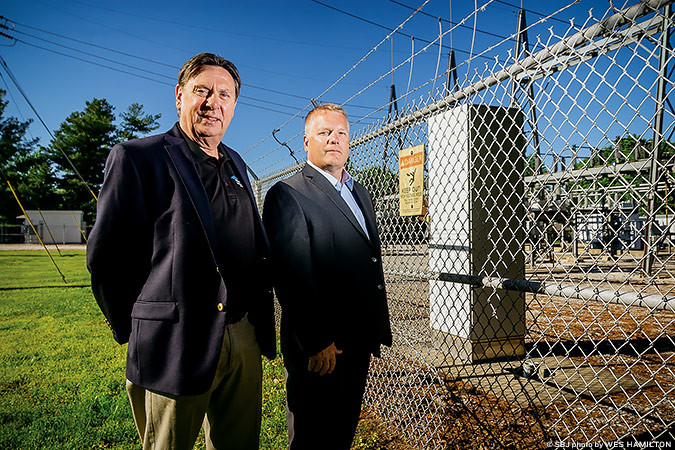NorthStar Battery and City Utilities of Springfield entered a joint agreement to build a battery-powered electricity storage system in southwest Springfield. The move represents a diversification of NorthStar’s principal telecommunications market, which officials say has become saturated.
The companies plan a September installation of 1,100 batteries – each about twice the size of an average car battery – at CU’s substation on Cox Road just south of Republic Road.
For CU, officials say the energy storage system would supplement other renewables, like wind and solar, and help meet demand during peak usage times.
“It works in concert with the renewables that are in place,” said Jay Lohrbach, CU’s manager of generation projects, noting the system would “make up for those times when the sun doesn’t shine and the wind doesn’t blow.”
Renewable inventory
Existing renewable energies harnessed already charge Springfield but with shortcomings. The sun accounts for 5 megawatts worth of energy from CU’s own solar plant, and wind accounts for 250 megawatts.
“The difference with the other renewables is that energy for wind is only there when the wind is blowing, and solar energy is only there when the sun is out,” Lohrbach said.
Since 2009, the utility has purchased 50 megawatts of electricity from the Smoky Hills Wind Farm near Salina, Kansas. And in January, CU began a 22-year agreement purchasing up to 200 megawatts of electricity from the Frontier Windpower Project in northern Oklahoma.
A recent CU blog post indicates the publicly owned utility now has the capacity to distribute 30 percent of Springfield’s power from renewable energy sources, including hydro and methane gas. The city harnesses methane gas produced by Springfield’s landfill, which converted to electricity provides residents 3.2 megawatts of energy, according to CU’s website.
CU and NorthStar will split the cost of the roughly $1 million energy storage facility, said NorthStar senior adviser Frank Fleming.
Construction of a small building on the property – about 40-feet long and 10-feet wide – and battery installation will be completed by the companies.
While the battery-energy production is small starting out – only 1 megawatt – officials say the project spells opportunity for more, and it is the right thing to do environmentally.
“We’re not required to provide any kind of clean energy. It’s all voluntary,” CU spokesman Joel Alexander said.

SMART TECH: NorthStar’s Advanced Connected Energy monitoring system allows users to retrieve data wirelessly.
Graphic provided by NORTHSTAR BATTERY
Market saturation
For NorthStar, the venture represents a new opportunity as the company’s principal market, telecommunications, has become saturated.
“The market has become saturated because there are a lot of cellular networks,” Fleming said.
NorthStar, a Stockholm, Sweden-based battery and power solutions company with North American headquarters in Springfield, is developing new ways to position its technology.
“NorthStar is looking at open market opportunities; probably the biggest is the storage of energy,” Fleming said. “We believe NorthStar has battery technology that is very capable of meeting those energy storage requirements.”
The energy storage system market is estimated to grow to $200 billion-$400 billion by 2040, according to data provided by the companies. The New Energy Outlook 2016 Report by Bloomberg New Energy Finance additionally projects in the next 20 years, 60 percent of installed capacity would be made up of zero-emission energy sources.
For the Springfield project, NorthStar is implementing its Advanced Connected Energy monitoring system that allows users to retrieve real-time and historical performance data wirelessly, both locally through a smartphone app and remotely through a cloud service.
NorthStar officials say it works by combining Bluetooth communication with an internet of things concept.
“Battery energy storage will be one of the biggest uses of batteries in five to 10 years,” Fleming said.
Lohrbach said CU’s battery system’s footprint would be less than an acre, much smaller than the substation it will sit next to. Officials estimate it would be able to power 800 homes for an hour, or 100 homes for up to 8 hours.
Should the new energy prove efficient in managing system peak loads, officials say they’ll investigate the possibility of a utility-scale battery storage system.
According to the American Public Power Association, the CU-NorthStar project would be one of the first such storage systems in the Midwest.
[[In-content Ad]]

